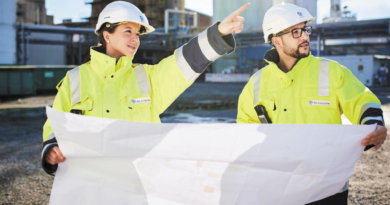
Ensuring Product Safety and Physical Traceability Is Crucial
The European Union’s Farm to Fork Strategy undoubtedly marks a major turning point for the coming years and reflects the ambition to make the European food system safer, healthier, and more invested in sustainable development.
For the first time, the European Union is giving itself the means to implement a “Food Value Chain” regulation with clear and measurable objectives throughout the entire value chain, from production and distribution to consumption.
This comprehensive strategy sets out the legislative initiatives for the years to come aiming at making the European food system more sustainable in terms of environmental impact while bringing economic, social and health benefits. Two of the most striking initiatives are undoubtingly the safety and sustainable development of the food value chain, as they impact consumer health safety.
Food Value Chain at Risk
The safety of the European food system is threatened on multiple fronts. Illegal, undeclared or unregulated activities have been rampant in the supply chain for a long time: false designations, outdated recycled and reprocessed products, fake organic products, the substitution of authorised substances by dangerous ones, the introduction of or substitution by fake products in the circuits are dramatic examples of the criminal practices to which consumers are exposed. According to some studies, 1 in 3 French people has bought counterfeit food.
In addition to these “frequent” illicit practices, the COVID crisis has highlighted the importance of a resilient supply chain capable of surviving such a major shock without any disruption. While the supply chain partly withstood the shock of the crisis, it did not come out unscathed: the number of seizures of non-compliant, expired or altered food products was considerably higher during the crisis, proving without the shadow of a doubt that criminal networks are taking advantage of the disruption of the supply chains to introduce counterfeit, non-compliant or illegal products into the flows.
It is absolutely essential to ensure the safety of the food value chain, on the one hand to protect the consumer, and on the other hand, in the event of a crisis such as the one we have experienced, to ensure the safety, stability and resilience of the chain itself.
It is also crucial to clearly differentiate between the actors involved in the quality and safety of the food value chain and the other stakeholders.
Blockchain, the Illusion of a Solution
How can this be achieved? Blockchain technologies-related initiatives are currently flourishing. But beyond the “buzzword”, what exactly does this mean? Very schematically, Blockchain is a technology for storing and transmitting encrypted and distributed information, without any central storage facility. It records all the transactions carried out from a given moment onwards and distributes them in “blocks”, which makes it possible, through comparison, to detect any data falsification. As Blockchain technology has worked wonders in finance and fintech, it is now seeking to integrate other application areas. In the food value chain, for example, it would be possible to secure all transactions: every invoice, transport and delivery note could be identified, integrated into the value chain and their integrity checked. By doing so, it would be possible to secure the entire value chain, and, as a result, the entire food value chain.
Blockchain technology is an excellent tool for transaction security. But is it able to ensure the security of the food system? The answer is a clear and resounding NO. It can only secure transactions. Although it is capable of securing operations along the value chain, it lacks a key attribute: security, i.e. the physical security of the products. It appears that, despite all transactions – purchases, transport, deliveries – being legitimate, fake goods are being introduced into the value chain. OK, products are bought at one location and delivered to another one, but how can we make sure that fakes are not introduced somewhere along the line, either upstream or downstream?
By taking advantage of the lack of physical Track and Trace Solutions, this is precisely how unscrupulous operators and criminals successfully operate.
Imagine a monetary system where transactions would be totally secured through Blockchain (or any another solution) but notes and denominations would not! Counterfeit banknotes would seamlessly blend in with the genuine ones, ultimately destroying the entire system and public trust. This is exactly what is currently happening in the food value chain. And consumers are fully aware of it.
Ensuring the Physical Security of Products: Authenticating & Tracing

The only viable manner to truly secure a system, food or any other, is to incorporate a unitary identification and a digital security marking physically on the products – or on the primary container closest to the product – to authenticate the latter and trace them unitarily throughout their life cycle. A number of health, cosmetics, and luxury goods companies (some close to the food industry) which are under extreme pressure from illicit practices have long understood and implemented this system. This technology has enabled them to successfully detect and reduce fraud and embezzlement, control production and distribution channels and networks, attract and reassure their consumers, and secure their loyalty. Product physical security and unitary traceability is the only way to guarantee a secured food value chain.
Advantages of the Digital Unitary Authentication Technology (PUF1) in Ensuring Product Physical Security
First, with the digital traceability authentication technology, forgeries can be detected immediately and remotely thanks to the product unitary digital identifier, or “Digital ID”: the product, marked for its lifetime, can be authenticated and traced at all stages in the supply chain all the way to the consumer. Second, any illicit practice will be detected, too. Why has the code disappeared? Why are these products no longer in their original batch or consignment? How come they end up on a market which is not the one they were initially intended for? Why has the product been tampered with? When irregularities are detected, corrective measures are taken, either at the manufacturer level or, in the event of a health risk, at the level of the authorities; product recalls are targeted and safe; product monitoring, and manu- facturer – or brand – organisation is up to scratch.
Improved Information and Relations with the Consumer
In addition to safety benefits, the digital marking technologies provide a crucial benefit to manufacturers as regards consumer relations. Producers need to prepare today for the new packaging and labelling rules.
The packaging space taken up by mandatory information – labelling of origin or place of provenance, nutritional information, as well as climate, environment, and even social data – will increase considerably in the future, leaving little space for producer information.
So, new labelling practices will have to be put in place, as consumers will no longer be satisfied with the limited information provided by the manufacturer. With consumers becoming increasingly demanding, producers need to find new channels to demonstrate the quality of their products, maintain trust and build consumer loyalty.
Through digital marking technologies, a simple click on a smartphone connects the brands directly to the consumers to supply them, on the one hand, with the compulsory indications that can be certified by a trusted third party, and on the other, with the information brands consider relevant to differentiate themselves from their competitors and promote their products. Moreover, these digital technologies are extremely flexible and scalable: the information available to the consumer can be adapted in time and space, in keeping with current events and circumstances. So, they enable virtuous companies to highlight their involvement in improving the food value chain and promote the benefits of their products.
Economically Viable Solutions
Finally, marking technologies are the perfect answer to the problems of economic feasibility. In the wake of the publication of the Farm-to-Fork Strategy, concern arose regarding the costs of implementing such measures. Some warned against the risk of exploding costs, leading to indebtedness and the disappearance of the actors most at risk, such as SMEs, organic producers, or small producers. Fortunately, digital marking technologies are extremely cost-efficient and can be implemented at minimal cost, largely offset by the commercial and other benefits. They integrate seamlessly into existing marking and printing processes, require no additional consumables – no special inks, no holograms, and no special tags – and have a zero-carbon footprint. So, the cost of these solutions is more than offset by the users’ benefits, both in terms of safety and the relationship of trust with the consumer.
The Farm-to-Fork Strategy is undeniably one of the most ambitious initiatives at the global level aiming at ensuring the safety and sustainability of a food system. All the implications are not yet fully known and will become clearer as the Strategy is being implemented.
Europe will unquestionably become one of the most regulated but safest food regions in the world. This represents a tremendous opportunity for producers and manufacturers to implement real safety and traceability strategies and to integrate these assets to ensure and regain consumer confidence in Europe and beyond.
For the other regions of the world, Asia or the Americas, where consumers share the same concerns and fears, the demand for authenticable European products with guaranteed traceability is growing rapidly, opening up new opportunities and markets for companies that know how to evolve and adapt. The technologies are available, they are safe, proven, and economically viable and – if it were the EU political will – would even fit effortlessly into the eIDAS trust environment. The companies that use them are the first to stand out and benefit from this new environment.
About Advanced Track & Trace
Advanced Track & Trace® develops innovative authentication, identification and tracking technologies for a better protection of products, companies, citizens, and trade. For over 15 years, Advanced Track & Trace® has had trust-based relationships with leading customers and partners: companies, governments, institutions, based on its ability to offer creative, valuable, reliable, and durable solutions. www.att-fr.com
For more information, please contact info@ att-fr.com




